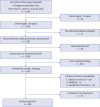1. Cheskes S, Schmicker RH, Rea T, Morrison LJ, Grunau B, Drennan IR, et al. The association between AHA CPR quality guideline compliance and clinical outcomes from out-of-hospital cardiac arrest. Resuscitation. 2017; 116:39–45.

2. Grunau B, Puyat J, Wong H, Scheuermeyer FX, Reynolds JC, Kawano T, et al. Gains of continuing resuscitation in refractory out-of-hospital cardiac arrest: a model-based analysis to identify deaths due to intra-arrest prognostication. Prehosp Emerg Care. 2018; 22(2):198–207.

3. Shin SD, Ong ME, Tanaka H, Ma MH, Nishiuchi T, Alsakaf O, et al. Comparison of emergency medical services systems across Pan-Asian countries: a web-based survey. Prehosp Emerg Care. 2012; 16(4):477–496.

4. McMullan J, Gerecht R, Bonomo J, Robb R, McNally B, Donnelly J, et al. Airway management and out-of-hospital cardiac arrest outcome in the CARES registry. Resuscitation. 2014; 85(5):617–622.

5. Saner H, Morger C, Eser P, von Planta M. Dual dispatch early defibrillation in out-of-hospital cardiac arrest in a mixed urban-rural population. Resuscitation. 2013; 84(9):1197–1202.

6. Hollenberg J, Riva G, Bohm K, Nordberg P, Larsen R, Herlitz J, et al. Dual dispatch early defibrillation in out-of-hospital cardiac arrest: the SALSA-pilot. Eur Heart J. 2009; 30(14):1781–1789.

7. Sun JT, Chiang WC, Hsieh MJ, Huang EP, Yang WS, Chien YC, et al. The effect of the number and level of emergency medical technicians on patient outcomes following out of hospital cardiac arrest in Taipei. Resuscitation. 2018; 122:48–53.

8. Fiala A, Lederer W, Neumayr A, Egger T, Neururer S, Toferer E, et al. EMT-led laryngeal tube vs. face-mask ventilation during cardiopulmonary resuscitation - a multicenter prospective randomized trial. Scand J Trauma Resusc Emerg Med. 2017; 25(1):104.

9. Benoit JL, Gerecht RB, Steuerwald MT, McMullan JT. Endotracheal intubation versus supraglottic airway placement in out-of-hospital cardiac arrest: a meta-analysis. Resuscitation. 2015; 93:20–26.

10. Kajino K, Kitamura T, Iwami T, Daya M, Ong ME, Nishiyama C, et al. Impact of the number of on-scene emergency life-saving technicians and outcomes from out-of-hospital cardiac arrest in Osaka city. Resuscitation. 2014; 85(1):59–64.

11. Warren SA, Prince DK, Huszti E, Rea TD, Fitzpatrick AL, Andrusiek DL, et al. Volume versus outcome: more emergency medical services personnel on-scene and increased survival after out-of-hospital cardiac arrest. Resuscitation. 2015; 94:40–48.

12. Nordberg P, Hollenberg J, Rosenqvist M, Herlitz J, Jonsson M, Järnbert-Petterson H, et al. The implementation of a dual dispatch system in out-of-hospital cardiac arrest is associated with improved short and long term survival. Eur Heart J Acute Cardiovasc Care. 2014; 3(4):293–303.

13. Joyce SM, Davidson LW, Manning KW, Wolsey B, Topham R. Outcomes of sudden cardiac arrest treated with defibrillation by emergency medical technicians (EMT-Ds) or paramedics in a two-tiered urban EMS system. Prehosp Emerg Care. 1998; 2(1):13–17.

19. Sund B. Developing an analytical tool for evaluating EMS system design changes and their impact on cardiac arrest outcomes: combining geographic information systems with register data on survival rates. Scand J Trauma Resusc Emerg Med. 2013; 21(1):8.

20. Nordberg P, Jonsson M, Forsberg S, Ringh M, Fredman D, Riva G, et al. The survival benefit of dual dispatch of EMS and fire-fighters in out-of-hospital cardiac arrest may differ depending on population density--a prospective cohort study. Resuscitation. 2015; 90:143–149.
21. Stopyra JP, Courage C, Davis CA, Hiestand BC, Nelson RD, Winslow JE. Impact of a “Team-focused CPR” protocol on out-of-hospital cardiac arrest survival in a rural EMS system. Crit Pathw Cardiol. 2016; 15(3):98–102.

22. Ono Y, Hayakawa M, Iijima H, Maekawa K, Kodate A, Sadamoto Y, et al. The response time threshold for predicting favourable neurological outcomes in patients with bystander-witnessed out-of-hospital cardiac arrest. Resuscitation. 2016; 107:65–70.

23. Gold LS, Fahrenbruch CE, Rea TD, Eisenberg MS. The relationship between time to arrival of emergency medical services (EMS) and survival from out-of-hospital ventricular fibrillation cardiac arrest. Resuscitation. 2010; 81(5):622–625.

24. Jarman AF, Hopkins CL, Hansen JN, Brown JR, Burk C, Youngquist ST. Advanced airway type and its association with chest compression interruptions during out-of-hospital cardiac arrest resuscitation attempts. Prehosp Emerg Care. 2017; 21(5):628–635.

25. Kang K, Kim T, Ro YS, Kim YJ, Song KJ, Shin SD. Prehospital endotracheal intubation and survival after out-of-hospital cardiac arrest: results from the Korean nationwide registry. Am J Emerg Med. 2016; 34(2):128–132.

26. Kim KH, Shin SD, Song KJ, Ro YS, Kim YJ, Hong KJ, et al. Scene time interval and good neurological recovery in out-of-hospital cardiac arrest. Am J Emerg Med. 2017; 35(11):1682–1690.

27. Kim TH, Lee K, Shin SD, Ro YS, Tanaka H, Yap S, et al. Association of the emergency medical services-related time interval with survival outcomes of out-of-hospital cardiac arrest cases in four asian metropolitan cities using the scoop-and-run emergency medical services model. J Emerg Med. 2017; 53(5):688–696.e1.

28. Shin SD, Kitamura T, Hwang SS, Kajino K, Song KJ, Ro YS, et al. Association between resuscitation time interval at the scene and neurological outcome after out-of-hospital cardiac arrest in two Asian cities. Resuscitation. 2014; 85(2):203–210.

29. Eschmann NM, Pirrallo RG, Aufderheide TP, Lerner EB. The association between emergency medical services staffing patterns and out-of-hospital cardiac arrest survival. Prehosp Emerg Care. 2010; 14(1):71–77.









 PDF
PDF Citation
Citation Print
Print





 XML Download
XML Download